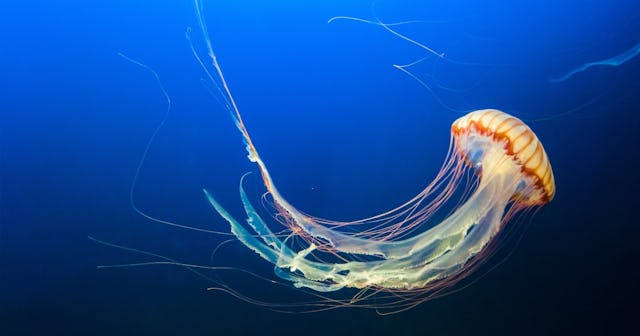To Pee, Or Not To Pee: What To Know About Treating A Jellyfish Sting

This article has been medically reviewed by Howard Orel, MD. Board-certified and a Fellow of the American Academy of Pediatrics, Dr. Orel runs an active general pediatric practice, Advocare Marlton Pediatrics. He also serves as CEO of Advocare — one of the largest independent medical groups in the country.
If like many people, everything you know about jellyfish sting treatment comes from that one episode of Friends or dad jokes about the benefits of urine, you have a few things to learn about jellyfish sting first aid. First of all, if you’ve never been stung by a jellyfish yourself, you should know that it can be extremely painful, and not just sting, it feels like a burn. As in, they can hurt worse than a bee sting (in most cases and for people who aren’t allergic). Like, willing-to-let-someone-pee-on-you-painful. That’s why it’s so important to know how to treat a jellyfish sting right away, as well as how long the stings tend to last, and whether there’s any cure for the wound. Here’s what to know about jellyfish sting treatment before you hit the beach next.
What to Know About Jellyfish Stings
You can probably close your eyes and picture a jellyfish — all blobby with tentacles. And while some jellyfish certainly do look like this, you should know that jellyfish come in a wide array of sizes and colors, and not all of them have tentacles. This means that jellyfish can be sneaky; just because you did a quick scan for jellyfish in the water doesn’t mean you’ll be able to see all of them. For example, some jellyfish are relatively small, round, and entirely clear, so you won’t know that you’ve come in contact with one until the stinging starts. Having said that, not all jellyfish stings are equally painful: some are uncomfortable but don’t have you writhing in agony, while others can cause full-body systemic reactions, which, in some cases, can be life-threatening, according to the Mayo Clinic.
A few more things to keep in mind. First, jellyfish live in oceans around the world (i.e. there’s no escape), but the most dangerous ones are found in Australia, the Philippines, the Indian Ocean, and the central Pacific Ocean, KidsHealth explains. Also, while jellyfish don’t actively hunt humans to torture, all it takes is touching or brushing up against one while swimming, or stepping on one (even if it’s dead) to get a painful sting.
Jellyfish Sting Symptoms
In most cases, a jellyfish sting starts hurting immediately, so if you ever feel something suddenly painful while swimming or walking on the beach, it’s best to stop what you’re doing and check it out right away. According to the Mayo Clinic, the most common signs and symptoms of a jellyfish sting are:
- Burning, prickling, stinging pain
- Red, brown, or purplish tracks on the skin — a “print” of the tentacles’ contact with your skin
- Itching
- Swelling
- Throbbing pain that radiates up a leg or an arm
More serious jellyfish stings can also involve reactions in different systems of the body, either right away, or after a few hours. These symptoms can include (again, per the Mayo Clinic):
- Stomach pain, nausea, and vomiting
- Headache
- Muscle pain or spasms
- Weakness, drowsiness, fainting, and confusion
- Difficulty breathing
- Heart problems
How to Treat a Jellyfish Sting
Now it’s time to learn the basics of jellyfish sting first aid, and what to do if you or someone you know is stung:
- Get the person who was stung out of the water.
- Rinse the sting with either sea/salt water or vinegar. Do not rinse it with fresh water, the Cleveland Clinic advises.
- Use tweezers to gently pluck any tentacles left on the skin.
Note that this is the bare minimum, and action you can take right away — provided you keep a small bottle of vinegar and some tweezers in your beach bag (which we recommend you do). And while you’re providing the initial first aid for the jellyfish sting, there are a few things (other than rinsing it with fresh water) to avoid:
- Do not scrape off any stingers still in the skin. While this used to be recommended, we now know it can make things worse, KidsHealth explains.
- Do not rub the area with the sting with a towel, your hand, or anything else.
- Do not apply ice packs to the affected skin.
Once you’re able to get home (or somewhere with a bath/shower), the Mayo Clinic recommends soaking or immersing the area that was stung in hot (but not scalding) water for 20 to 45 minutes. Meanwhile, the Cleveland Clinic has a more elaborate treatment method involving more vinegar, shaving cream, baking soda, and a credit card.
So where does the pee come in?
The truth is, it doesn’t — the idea of treating a jellyfish sting with urine is a myth, the University of Arkansas for Medical Sciences explains. There is no research backing the idea that pee helps a jellyfish sting. Urinating on such an injury can actually make the sting worse. After a jellyfish stings you, it releases cells called nematocyst, which is venom. If you pee on the sting, it can cause the cells to release more poison (and more pain). So, if you’re thinking of Friends right now and when Monica got stung by a jellyfish, that awkwardness could have totally been avoided.
And how long do jellyfish stings last? That all depends on the severity of the sting. Sometimes the pain will go away in a few hours. Other times, the sting could result in a rash that sticks around for a few weeks. While there is no official jellyfish sting cure, the Cleveland Clinic notes that applying calamine lotion or hydrocortisone cream to the sting or rash can help.
This article was originally published on